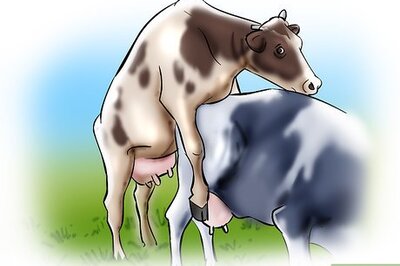
views
Since the very first presentation of Central Vista’s blueprint two years ago to the beginning of its construction early this year, the designs of the new Parliament building and other structures that are part of the project underwent multiple amendments before they were finally cleared by the Delhi Fire Services (DFS), CNN-News18 has learnt.
Atul Garg, Director DFS, said the design of the project was amended several times till it completely complied with the provisions of building by-laws. So far as the fire-safety features are concerned, the project is believed to be the country’s ‘most fire-safe’ construction, Garg said.
“The only reason to repeatedly amend it over multiple meetings held with other stakeholders was to make sure that in case of a fire, we have zero casualties. The construction began only once we approved the design and after the construction is complete, a detailed joint inspection will be done,” he added.
CNN-News18 spoke to different officials in the Delhi Fire Services to chart out amendments that the design underwent to earn the distinction. Take a look at the 10 major fire-safety features of Central Vista:
ACCESS AND INTERNAL ROADS
The first major concern since the beginning of the project was that Parliament building and other structures in Central Vista must have a broader approach road and wide-enough internal roads for easy and smooth movement of fire tenders in case of a blaze.
“The shorter the approach, faster is the response time. Broad approach paths and internal roads will help in smooth deployment of multiple fire tenders and their quick movement simultaneously, depending on how big the fire is,” said a senior officer.
STAIRS ARE VITAL
The fire department had made it clear to the architects involved in the construction that the width of a staircase should be adequate and the number of steps must be limited to make evacuation easy.
“Both the width and the number of steps are decided depending upon various factors, including the footfall, height and number of floors in a building as well as number of exit and entry points. Evacuees may take longer to escape due to very long staircases and inadequate width could cause bottlenecks when large number of occupants try to flee at the same time,” the officer added.
SHORT ESCAPE DISTANCES
During a fire, while trying to escape through a corridor of any of the Central Vista buildings, an evacuee shall be able to cover the distance in the shortest-time possible, another DFS officer said. As per the rules, at every 15 meters or less, there shall be a dead-end, which means that a person will not travel a longer distance to find an exit point.
“Many times, we amend the designs of buildings to ensure shorter dead ends. This will help firefighters in quicker evacuation and will also make it easier for the occupants of the building to escape faster,” the officer said.
COMPARTMENTATION
Every floor of all the buildings in Central Vista is divided into two or more compartments, depending on the floor size. All the compartments are connected with one another through a “fire-check door”. Officials say such division helps in containing a blaze and prevents it from spreading across the floor.
“With compartmentation, in case of a fire, we can shift the occupants of a floor to the adjoining compartment. Any two compartments are connected through fire-check doors made of steel and wood which have high fire-resistance rating. This means they take time to burn down and do not allow the blaze to spread through them for a long time. Slow spread of fire also allows firefighters time to douse the blaze,” said another officer.
FIRE TOWERS
These are fire-resistant towers dedicated for firefighting and rescue that stand parallel to any building with an opening on every floor. At every floor, these towers have double fire-check doors with pressurization system.
“This means that between the two fire-check doors at every floor, air pressure is maintained in order to disallow smoke from entering the tower. These towers are only accessed by firefighters and rescuers. There are no other openings in these towers other than the ones through which they are connected to the building’s main floors,” the official added.
PRESSURIZATION SYSTEM
This refers to a system wherein air pressure is maintained using axil fans to prevent the ingress of smoke and hot gases in the staircase and lift lobbies. This makes the entry of rescuers and firefighters easier and doesn’t allow the smoke to accumulate.
“This system will be installed in all the high-rise buildings of Central Vista. Axil fans are installed in such a way that they keep the staircases, lift lobbies, escape corridors and fire towers free of smoke and gases that may cause trouble in recue and firefighting,” DFS officials said.
SMOKE MANAGEMENT
“We have also ensured the use of mechanical ventilation. Installation of exhaust fans and maintaining thorough ventilation with proper structural changes will help in drawing smoke out of a building quickly. It is important to ensure no accumulation of smoke and hot gases as it may delay the rescue of occupants and dousing of the blaze,” the officer said.
The officer added that majority of casualties in a fire incident are because of asphyxiation. “If our smoke management system in the new buildings is fool-proof, it will help us in keeping the casualty count low in case of a fire,” he said.
ACCESS TO ROOFTOP
Access to rooftop was a bone of contention between the DFS and the security agencies concerned when it came to introducing fire-safety features in the buildings of Central Vista.
“In case of a major fire in a high-rise building, people who are trapped on floors above the fire can be rescued from the rooftop. It was a security concern for agencies to allow access to rooftop. Over multiple meetings, however, we managed to convince them so that those who cannot rush down can escape to the roof. In order to introduce this feature, agencies had to put in additional security measures on the roofs,” another officer said.
FIRE-PROOF LIFT LOBBIES
Based on the recommendations of the DFS, the architects of the buildings introduced fire-proof lift lobbies in all high-rise buildings.
“Lift lobbies are separated from the main buildings with fire-check doors. This will help the occupants use the lift without being affected by the smoke. These doors also keep fire away from the lift lobby for a longer time. In case the fire starts from the lift area, it will help in preventing the smoke from entering the main building,” the fire officer said.
FIRE-FIGHTING SYSTEMS
Apart from structural changes and design modifications, the DFS also ensured installation of equipment and fire-fighting systems in the buildings.
These arrangements include installation of fire extinguishers and hose reels, automatic fire detection and water sprinkler systems, manual fire alarms, down-comer and wet-riser, internal and external hydrants along with underground and overhead water tanks with water pumps, the officer said.
Read all the Latest News India and Breaking News here



















Comments
0 comment